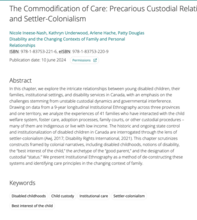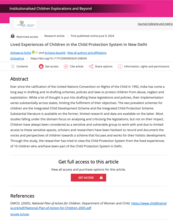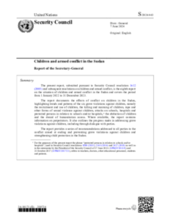Demographic Data
|
Sources: World Bank, UNICEF, UNDP HDR 2015, DHS 2011 |
Displaying 91 - 100 of 14379
In this session, we will be exploring the legal aspects of permanence and early permanence with our Legal Consultants Alexandra Conroy Harris, and Augusta Itua. This six part series is tailored specifically to recently qualified social workers, students and those wanting to find out more about adoption, fostering and kinship care.
In the complex work of caring for vulnerable children, we don't have to rely on guesswork or intuition to address challenges effectively. Research provides many insights that can make a practical difference in the way we care for vulnerable children. The CAFO Research Center invites you to join them to hear about some of the key findings, trends, and themes that research has to offer as it relates to care for kids.
More ‘grave violations’ committed in occupied territories and Israel than anywhere else in world, report says.
In this chapter, the authors explore the intricate relationships between young disabled children, their families, institutional settings, and disability services in Canada, with an emphasis on the challenges stemming from unstable custodial dynamics and governmental interference.
Through this study, the researcher has attempted to view the Child Protection System from the lived experiences of 10 children who are/have been part of the Child Protection System in Delhi, India.
In Kenya, economic challenges often force families to place their children in residential care facilities (sometimes referred to as orphanages), leading to long-term negative impacts.
The report documents the effects of conflict on children in the Sudan, highlighting trends and patterns of the six grave violations against children, namely the recruitment and use of children, the killing and maiming of children, rape and other forms of sexual violence against children, attacks on schools, hospitals and protected persons in relation to schools and/or hospitals, a the abduction of children and the denial of humanitarian access.
Discover the unforeseen ripple effects of child sponsorship programs with Laura Horvath, Jared Scheppman, and Kelly Strong as they dissect the challenges and triumphs in philanthropy's evolving landscape. The guests in this episode reveal how well-intentioned aid can sometimes miss the mark, inadvertently creating dependencies that hobble the very communities they intend to uplift. They also analyze the intricacies of international aid, focusing on the necessary shift from quick fixes to sustainable, community-driven development.
2024 Annual Meeting for Child Protection in Humanitarian Action.
A recent UNICEF report reveals that 30 to 50 percent of Haïti’s armed group members are children, coerced into service by persistent social, economic, and political instability. The escalating armed violence in the country has created a dire situation, particularly for the nation’s children, the United Nations International Children organization said.



